NVIDIA GeForce GTX 650 Ti Boost Review: Bringing Balance To The Force
by Ryan Smith on March 26, 2013 8:00 AM ESTCompute Performance
As always we'll start with our DirectCompute game example, Civilization V, which uses DirectCompute to decompress textures on the fly. Civ V includes a sub-benchmark that exclusively tests the speed of their texture decompression algorithm by repeatedly decompressing the textures required for one of the game’s leader scenes. While DirectCompute is used in many games, this is one of the only games with a benchmark that can isolate the use of DirectCompute and its resulting performance.
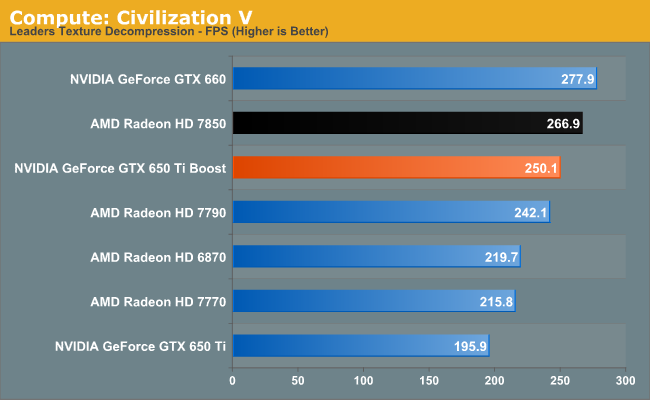
As our Civilization V compute benchmark is just that, a compute benchmark, so our results aren’t too surprising. This is one of the few compute tests NVIDIA does well at, so the GTX 650 Ti Boost is close to both Radeon cards, and not all that far behind the GTX 660 either.
Our next benchmark is LuxMark2.0, the official benchmark of SmallLuxGPU 2.0. SmallLuxGPU is an OpenCL accelerated ray tracer that is part of the larger LuxRender suite. Ray tracing has become a stronghold for GPUs in recent years as ray tracing maps well to GPU pipelines, allowing artists to render scenes much more quickly than with CPUs alone.
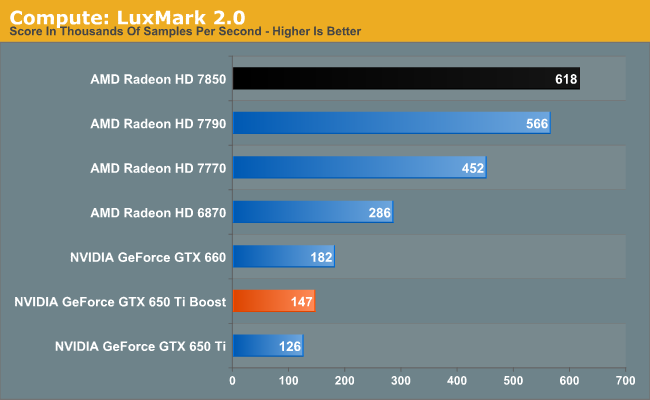
Moving on to LuxMark, we quite frankly transition into a more normal compute benchmark pattern for NVIDIA, which sees Kepler flopping. The GTX 650 Ti Boost can’t get even remotely close to a 7770, let alone the 7850. On the NVIDIA side it doesn’t help that since this is a compute benchmark the GTX 650 Ti Boost gains fairly little over the GTX 650 Ti.
Our 3rd benchmark set comes from CLBenchmark 1.1. CLBenchmark contains a number of subtests; we’re focusing on the most practical of them, the computer vision test and the fluid simulation test. The former being a useful proxy for computer imaging tasks where systems are required to parse images and identify features (e.g. humans), while fluid simulations are common in professional graphics work and games alike.
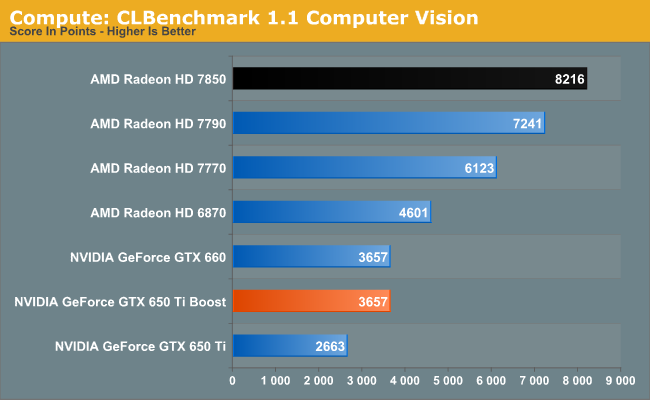

CLBenchmark is much the same as LuxMark, with NVIDIA cards bringing up the rear. The fluid simulation ends up being the more painful of the two benchmarks for the GTX 650 Ti Boost, clocking in at less than 1/3rd the performance of the 7850.
Moving on, our 4th compute benchmark is FAHBench, the official Folding @ Home benchmark. Folding @ Home is the popular Stanford-backed research and distributed computing initiative that has work distributed to millions of volunteer computers over the internet, each of which is responsible for a tiny slice of a protein folding simulation. FAHBench can test both single precision and double precision floating point performance, with single precision being the most useful metric for most consumer cards due to their low double precision performance. Each precision has two modes, explicit and implicit, the difference being whether water atoms are included in the simulation, which adds quite a bit of work and overhead. This is another OpenCL test, as Folding @ Home is moving exclusively OpenCL this year with FAHCore 17.
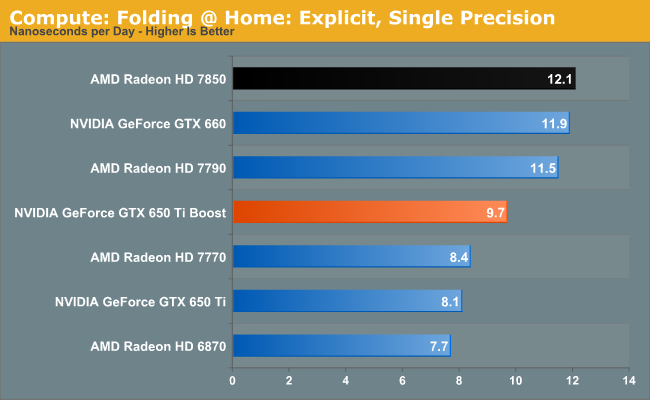
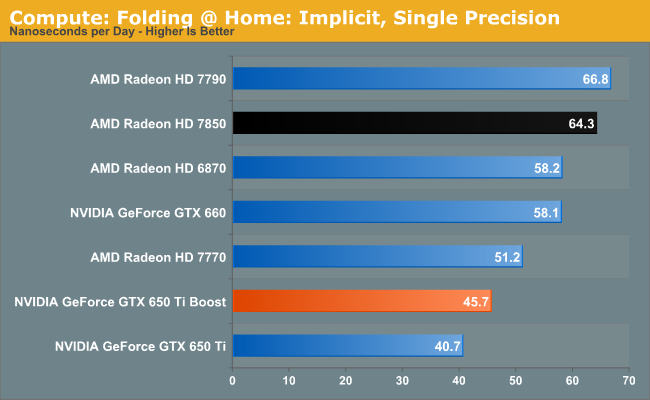
NVIDIA still struggles at compute with FAHBench – the move to OpenCL isn’t doing them any favors – but it’s not the blowout that was our last two benchmarks. Interestingly explicit favors NVIDIA more than implicit, which may mean NVIDIA is handling the overhead better than AMD is. Still, any Folding @ Home users will be far better served by AMD than NVIIDA here.
Our 5th compute benchmark is Sony Vegas Pro 12, an OpenGL and OpenCL video editing and authoring package. Vegas can use GPUs in a few different ways, the primary uses being to accelerate the video effects and compositing process itself, and in the video encoding step. With video encoding being increasingly offloaded to dedicated DSPs these days we’re focusing on the editing and compositing process, rendering to a low CPU overhead format (XDCAM EX). This specific test comes from Sony, and measures how long it takes to render a video.
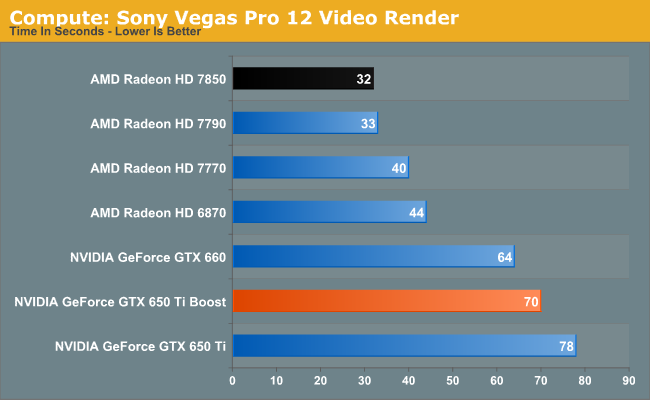
Vegas is another OpenCL benchmark, and another benchmark NVIDIA brings up the rear with. Certainly the additional compute performance of the GTX 650 Ti Boost over the GTX 650 Ti is helping NVIDIA here, but it can’t make up for a gap of over 30 seconds.
Wrapping things up, our final compute benchmark is an in-house project developed by our very own Dr. Ian Cutress. SystemCompute is our first C++ AMP benchmark, utilizing Microsoft’s simple C++ extensions to allow the easy use of GPU computing in C++ programs. SystemCompute in turn is a collection of benchmarks for several different fundamental compute algorithms, as described in this previous article, with the final score represented in points. DirectCompute is the compute backend for C++ AMP on Windows, so this forms our other DirectCompute test.
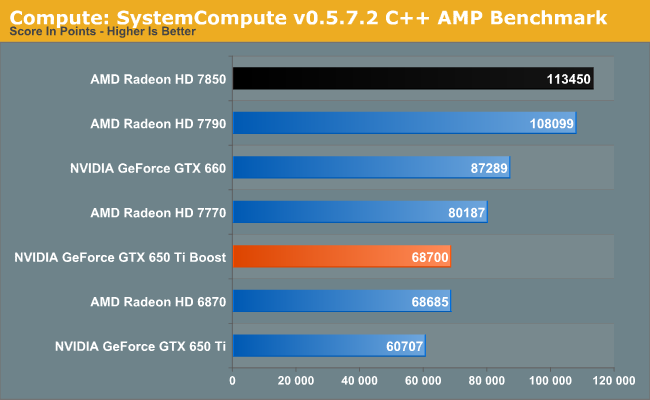
SystemCompute mixes things up a bit with its multiple sub-benchmarks, but it still doesn’t change the fact that Kepler and GTX 650 Ti Boost just don’t do that well in most compute scenarios. 68K points is enough to tie the 6870 of all things, itself not a particular good compute card. Otherwise the bar is set by AMD at over 100K points.










78 Comments
View All Comments
Zstream - Tuesday, March 26, 2013 - link
Any specific reason as to why the 1gb wasn't used?Zstream - Tuesday, March 26, 2013 - link
In addition, the 7790 will have 2gb cards as well so I'm just confused overall.DanNeely - Tuesday, March 26, 2013 - link
Probably because nVidia only sent a 2GB sample. I assume once retail cards are available a 1GB model will be tested too.Oxford Guy - Tuesday, March 26, 2013 - link
Of course they didn't send the 1GB model. It's absolutely completely positively ridiculous. It has no business existing.shandy706 - Tuesday, March 26, 2013 - link
They say why in the article. I think I'd read it before commenting.lol
Zstream - Tuesday, March 26, 2013 - link
I guess I don't see where that's in the article. Can you comment on the paragraph?shandy706 - Tuesday, March 26, 2013 - link
"Please note that the GTX 650 Ti Boost NVIDIA is sampling is the 2GB card. We’ll take a look at 1GB cards later once those arrive, since they were a late addition."Second page, very middle.
HighTech4US - Tuesday, March 26, 2013 - link
From page 2 (clear as day, if you just bothered to read)Please note that the GTX 650 Ti Boost NVIDIA is sampling is the 2GB card. We’ll take a look at 1GB cards later once those arrive, since they were a late addition.
Zstream - Tuesday, March 26, 2013 - link
Thanks for clearing that up. I will have to wait to see if the 2gb is a paper launch.Ryan Smith - Tuesday, March 26, 2013 - link
2GB 650 TiB launches this week. It will be 1G that will come later.